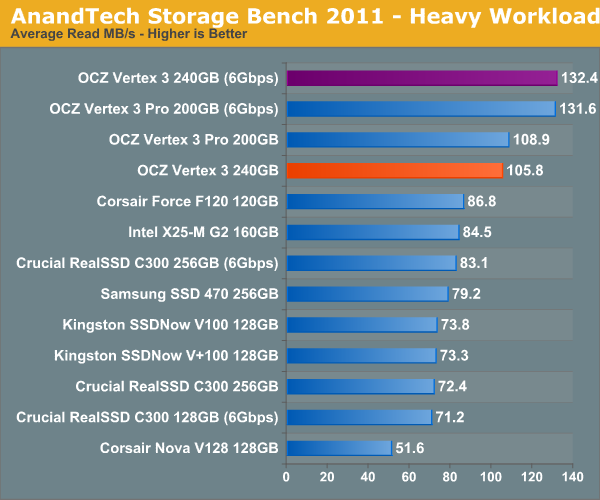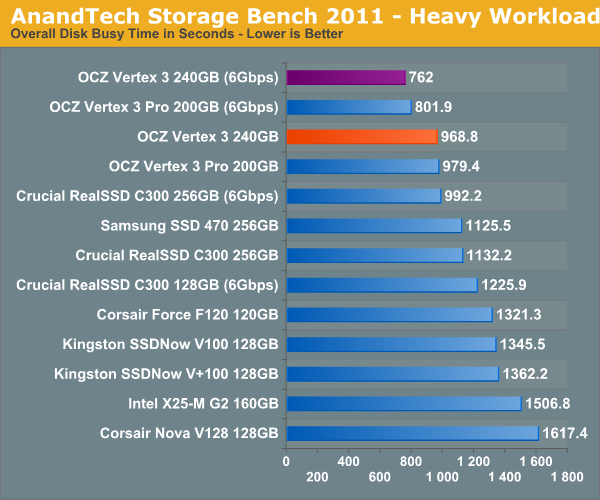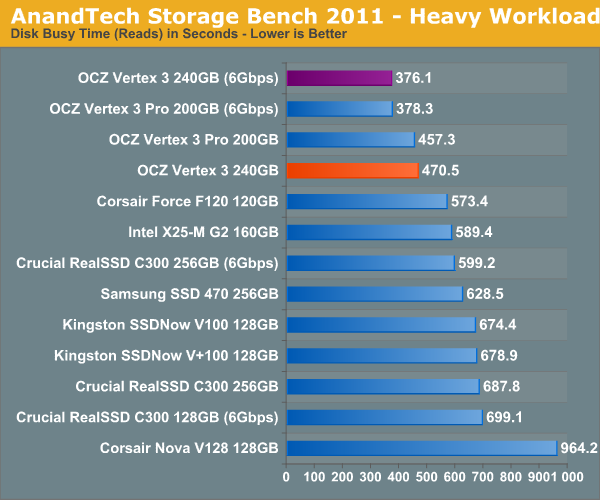OCZ Vertex 3 Preview: Faster and Cheaper than the Vertex 3 Pro
by Anand Lal Shimpi on February 24, 2011 9:02 AM ESTAnandTech Storage Bench 2011: Much Heavier
I didn't expect to have to debut this so soon, but I've been working on updated benchmarks for 2011. Last year we introduced our AnandTech Storage Bench, a suite of benchmarks that took traces of real OS/application usage and played them back in a repeatable manner. I assembled the traces myself out of frustration with the majority of what we have today in terms of SSD benchmarks.
Although the AnandTech Storage Bench tests did a good job of characterizing SSD performance, they weren't stressful enough. All of the tests performed less than 10GB of reads/writes and typically involved only 4GB of writes specifically. That's not even enough exceed the spare area on most SSDs. Most canned SSD benchmarks don't even come close to writing a single gigabyte of data, but that doesn't mean that simply writing 4GB is acceptable.
Originally I kept the benchmarks short enough that they wouldn't be a burden to run (~30 minutes) but long enough that they were representative of what a power user might do with their system.
Not too long ago I tweeted that I had created what I referred to as the Mother of All SSD Benchmarks (MOASB). Rather than only writing 4GB of data to the drive, this benchmark writes 106.32GB. It's the load you'd put on a drive after nearly two weeks of constant usage. And it takes a *long* time to run.
I'll be sharing the full details of the benchmark in some upcoming SSD articles (again, I wasn't expecting to have to introduce this today so I'm a bit ill prepared) but here are some details:
1) The MOASB, officially called AnandTech Storage Bench 2011 - Heavy Workload, mainly focuses on the times when your I/O activity is the highest. There is a lot of downloading and application installing that happens during the course of this test. My thinking was that it's during application installs, file copies, downloading and multitasking with all of this that you can really notice performance differences between drives.
2) I tried to cover as many bases as possible with the software I incorporated into this test. There's a lot of photo editing in Photoshop, HTML editing in Dreamweaver, web browsing, game playing/level loading (Starcraft II & WoW are both a part of the test) as well as general use stuff (application installing, virus scanning). I included a large amount of email downloading, document creation and editing as well. To top it all off I even use Visual Studio 2008 to build Chromium during the test.
Many of you have asked for a better way to really characterize performance. Simply looking at IOPS doesn't really say much. As a result I'm going to be presenting Storage Bench 2011 data in a slightly different way. We'll have performance represented as Average MB/s, with higher numbers being better. At the same time I'll be reporting how long the SSD was busy while running this test. These disk busy graphs will show you exactly how much time was shaved off by using a faster drive vs. a slower one during the course of this test. Finally, I will also break out performance into reads, writes and combined. The reason I do this is to help balance out the fact that this test is unusually write intensive, which can often hide the benefits of a drive with good read performance.
There's also a new light workload for 2011. This is a far more reasonable, typical every day use case benchmark. Lots of web browsing, photo editing (but with a greater focus on photo consumption), video playback as well as some application installs and gaming. This test isn't nearly as write intensive as the MOASB but it's still multiple times more write intensive than what we were running last year.
As always I don't believe that these two benchmarks alone are enough to characterize the performance of a drive, but hopefully along with the rest of our tests they will help provide a better idea.
The testbed for Storage Bench 2011 has changed as well. We're now using a Sandy Bridge platform with full 6Gbps support for these tests. All of the older tests are still run on our X58 platform.
AnandTech Storage Bench 2011 - Heavy Workload
We'll start out by looking at average data rate throughout our new heavy workload test:

If we break out our performance results into average read and write speed we get a better idea for the Vertex 3's strengths:


The next three charts just represent the same data, but in a different manner. Instead of looking at average data rate, we're looking at how long the disk was busy for during this entire test. Note that disk busy time excludes any and all idles, this is just how long the SSD was busy doing something:













85 Comments
View All Comments
swaaye - Thursday, February 24, 2011 - link
It'll depend on how fast your CPU is because it will become the bottleneck if it's not already.Mumrik - Thursday, February 24, 2011 - link
"Order enough controllers and you get a special firmware, otherwise you’re stuck with the stock SF-2200 firmware.(...)I do wish SandForce would just stick to a single spec and not play these sorts of games but that’s just how business works unfortunately."
Is it really? I've never heard of anything similar elsewhere in the storage space. This really sounds to me like the kind of thing you should keep pushing them on Anand....
taltamir - Thursday, February 24, 2011 - link
so... 7 "models" which are the exact same chip with different firmware / different configuration (supercap, amount of NAND, etc)And even within those so called "models" there is different levels of performance capping in firmware due to various exclusivity contracts which are not actually being reported or represented in the chip's name?
I am liking sandforce less and less.
TGressus - Thursday, February 24, 2011 - link
+1It's even more egregious when vendors are sending the reviewers pre-release samples that may or may not represent the final retail product.
taltamir - Thursday, February 24, 2011 - link
you are correct, that does make it even worse.jaydee - Thursday, February 24, 2011 - link
Interesting read from a theoretical perspective, but it would be far more useful for your readership to have a roundup involving 60-120GB SSD's. I can find benchmarks on budget video cards, cpu's, and read reviews on budget motherboards. I do realize there are no 60-120GB Vertex 3's available, but 6-9 months after launch I still have no idea how (for instance) the Sandforce, JMicron, Samsung, Indillinx, Marvell, Intel, Toshiba 60-90GB SSD's benchmark against each other considering they all scale down differently from the 240GB models which are often reviewed.240GB SSD's are neat, but not affordable for many.
86waterpumper - Thursday, February 24, 2011 - link
I agree, the 128gb size seems to be the sweet spot, that is what I've decided to go with, just not surewhether it will be the newest sandforce or the c400. I wish we could get some testing on the amd
motherboard controllers too. I know intel is more popular right now but amd is still a viable option
for many. I would think this is especially important since amd finally released a ahci driver not too
long ago, but I haven't heard much about how good it is.
ol1bit - Thursday, February 24, 2011 - link
I can't believe the jump, Intel better be on their game or they might find themselves without a market anymore.My Intel 80gb is old after 1.5 years! LOL
seapeople - Thursday, February 24, 2011 - link
Sell an x25m g2 for $1.5/GB and they are right back on top of the value/money game. Especially when you consider issues like reliability reputation versus these new drives. I wonder what the profit margin on these drives are... There might be a lot of leeway to drop price to capture market on these, considering their "real" competitors are HD's.boxleitnerb - Thursday, February 24, 2011 - link
Hey Anand,I was wondering if you're considering writing about the CPU-SSD dynamic in a future article. As I understand it, the SSDs can serve requests so fast that in some scenarios the CPU again becomes the limiting factor.
I would be especially interested in common tasks like virus scanning, gaming/application load times/installation and windows startup. I know this could be alot of work, so maybe you can pick only one or two of these tasks and analyze them with CPUs with a different number of cores and clock speeds.
What do you think about it?